Help us improve your experience. See content that is made for you!
See how IBM increased their efficiency by up to 30%!

Help us improve your experience. See content that is made for you!
See how IBM increased their efficiency by up to 30%!

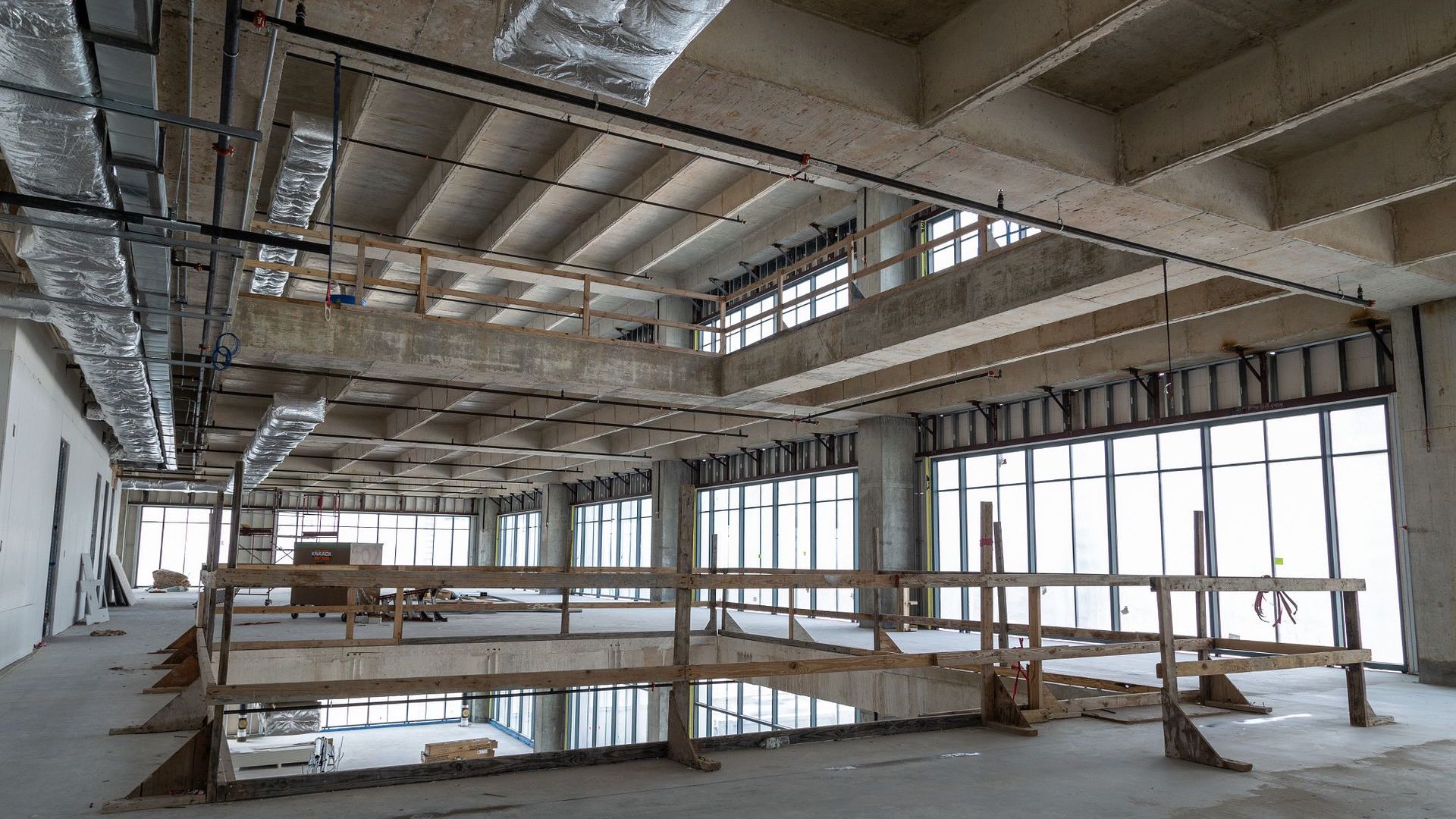
The construction industry has embarked on a massive and long journey toward digital transformation. While productivity has never been so high, profits and margins are still very low for most businesses. The potential for improvement is a huge opportunity, but companies still need help capturing new value from their markets. Furthermore, the pressure put on the environment is greater than ever, and the damages done to the planet are indisputable.
AEC companies across the globe are now inundated with new and pressing questions in this fast-paced environment. What is our mission? How will new technologies impact our business? What do we need to do to prepare for the future? How do we transform to become more data-centric?
Whether you are an owner, planner, designer, builder, supplier, operator, start-up entrepreneur, or big-company innovator, you need to pay attention to the smallest details and listen to the weakest signals to create or transform. One of these signals, often ignored, is what I call “The Invisible Revolution.”
More and more large construction firms are rethinking their business entirely. This slow but real process goes beyond just modernizing their activities and organization. The Invisible Revolution builds new data-driven companies to diversify their activities, adds new services to their ecosystems, and ultimately challenges how things are done in construction.
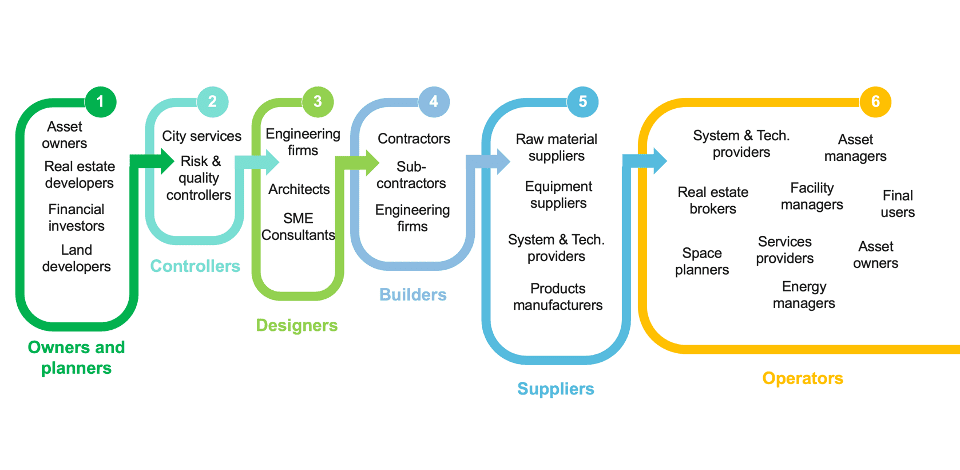
I’ve spent my entire life in construction and customer-facing roles. Most of my work involves meeting with executives from AEC firms to help them with their corporate strategy. It has been easy to observe that they already have a digital transformation strategy, plan, and roadmap. After years of investment and multiple partnerships with technology companies, they now feel the need to formulate their strategic initiatives better and need a third party to talk to. Execution is, of course, not easy, but most of the time, this is because formulation is unclear.
Six years ago, I started to inventory the strategic moves of the largest players across the construction industry to better advise these customers. I looked at the largest companies we all know within the ENR top 80 global contractors ranking: the Chinese firms, VINCI, Grupo ACS, Bouygues, Strabag, Eiffage, Larsen & Toubro, Skanska, Kajima, Bechtel, Ferrovial, Takenaka, Royal BAM, FCC, DPR, Porr, and Lendlease. I also included in this work the largest Architectural & Engineering firms: Jacobs, AECOM, WSP, SNC-Lavalin, Arcadis, Fluor, WorleyParsons, Mott MacDonald, Sweco, Arup, Ramboll, COWI, Aurecon, and White Arkitekter. Through this pursuit of non-academic research, several aspects started to emerge very clearly:
In this article dedicated to trends in construction, I highlighted this very same aspect: “In the coming years, data-culture-platform will be recognized as the trilogy for a successful digital transformation.”
Through my research, I learned a lot. Contrary to common belief, the construction industry is much more advanced than public perception. Large public companies operating in AECO receive a lot of pressure to perform, but they also have a good deal of resources. The most innovative firms are taking their destiny into their own hands, and they are now moving forward faster than ever to reach a new level of sophistication. They’ve grasped all the possibilities new technologies offer and adopted a growth mindset.
In recent years, top AECO firms have used digital technologies to test, develop, implement, and scale digital solutions to solve specific pain points. Later, they tried to adapt their processes and workflows. Ultimately, they tried to modernize them or even reinvent new ones. More recently, they started using digital platforms, usually commercial ones offered by technology companies, which changed everything.
Progressively, these firms learned from digital platforms as they changed their behaviors. A good analogy we can look at is social media for us individuals. We started to use Facebook, LinkedIn, Twitter, and Instagram years ago. How we used these platforms when we joined them and how we use them today are different. This is especially true if you look across generations. We are more engaged and active and understand how to use these tools to our advantage. This is the same for large corporations. Over the years, they learned from using digital platforms and they became more experienced, mature, and data-centric. The result is that they want to build their own digital platforms and adopt a growth mindset.
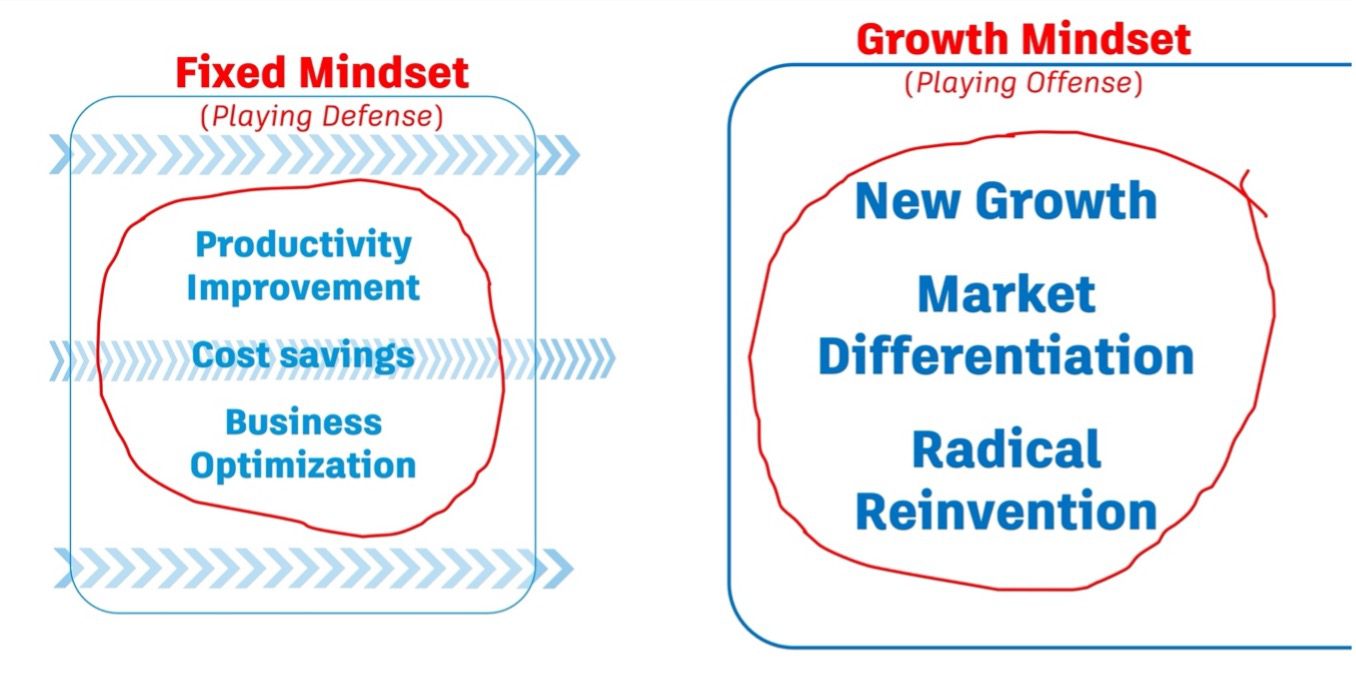
Some of the most advanced firms have reached a maturity point where they collect data, build their own digital platforms, operate them with new business models, and offer new services to their ecosystem. To make this more visible and transparent, I’ve highlighted some of these strategic initiatives. Some are internal initiatives launched to transform companies and prepare them for the future. They are taken from what we call the Arc of Transformation collection. Others are new business ventures they created to conquer new markets: this is what we call Hyper Construction.
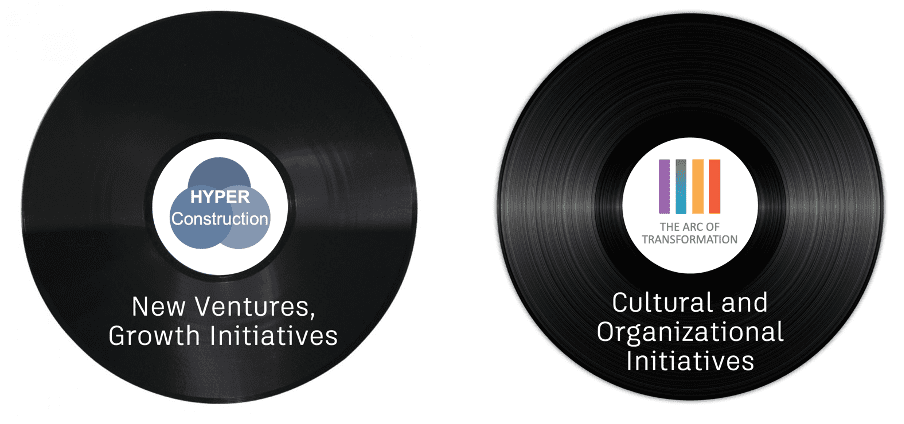
Ferrovial is a leading global infrastructure and services company that operates in four main business areas: transportation, construction, services, and toll roads. With a strong presence in over 20 countries, Ferrovial is known for its expertise in managing large-scale infrastructure projects, such as airports, highways, and railways. The company focuses on innovation and sustainability, delivering cutting-edge solutions to enhance mobility and improve quality of life.
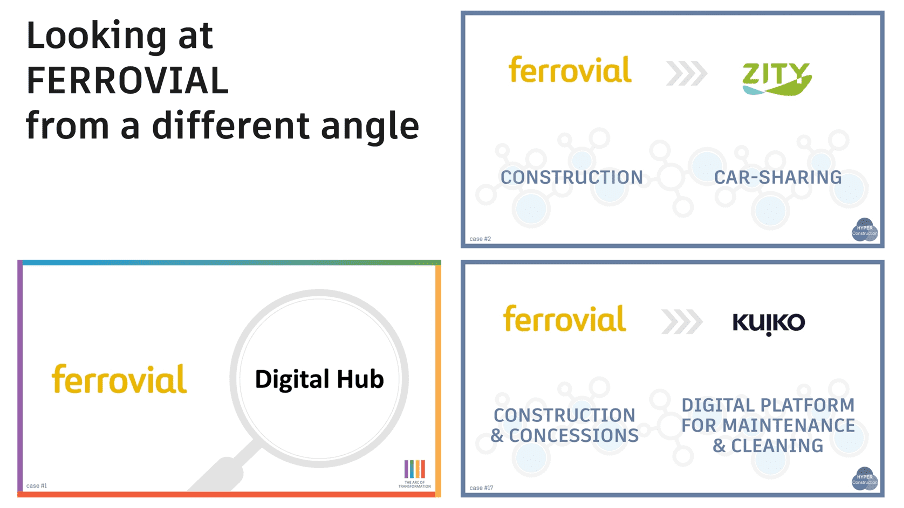
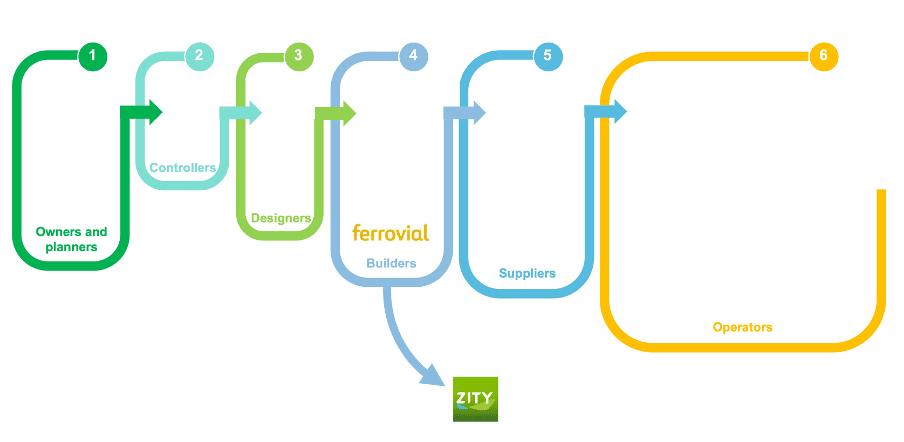 Ferrovial focuses on diversifying its activities and fostering innovation through various initiatives. One notable venture is the Ferrovial Digital Hub, an in-house innovation platform that promotes digital transformation across the organization. The Digital Hub identifies emerging technologies and collaborates with startups, universities, and other partners to develop innovative solutions for the infrastructure sector. Additionally, Ferrovial has ventured into urban mobility with initiatives like Zity, an electric car-sharing service that provides convenient and sustainable city transportation options. Kuiko is a digital platform connecting customers with local home maintenance and repair service providers. These initiatives demonstrate Ferrovial's commitment to exploring new business areas, leveraging technology, and delivering innovative services that enhance mobility and improve quality of life.
Ferrovial focuses on diversifying its activities and fostering innovation through various initiatives. One notable venture is the Ferrovial Digital Hub, an in-house innovation platform that promotes digital transformation across the organization. The Digital Hub identifies emerging technologies and collaborates with startups, universities, and other partners to develop innovative solutions for the infrastructure sector. Additionally, Ferrovial has ventured into urban mobility with initiatives like Zity, an electric car-sharing service that provides convenient and sustainable city transportation options. Kuiko is a digital platform connecting customers with local home maintenance and repair service providers. These initiatives demonstrate Ferrovial's commitment to exploring new business areas, leveraging technology, and delivering innovative services that enhance mobility and improve quality of life.
VINCI is a renowned multinational company specializing in construction, real estate development, and infrastructure. With a presence in more than 100 countries, VINCI is recognized for its expertise in designing, building, and operating complex projects in various sectors, including transportation, energy, and urban development. The company's commitment to sustainable development and digital transformation allows it to deliver extraordinarily innovative solutions.
VINCI actively pursues diversification and innovation through several initiatives. One such initiative is Sixense, a subsidiary of VINCI specializing in digital solutions for the construction industry. Sixense leverages data analytics, sensors, and artificial intelligence to optimize construction processes, monitor structures, and improve project efficiency. Another significant initiative is Leonard, VINCI's innovation and foresight platform. Leonard collaborates with startups, researchers, and industry experts to explore emerging trends, develop new business models, and foster innovation across VINCI's various sectors. Additionally, VINCI has its Digital by Desire program, which aims to digitize and streamline internal processes, enhancing collaboration and efficiency. These efforts highlight VINCI's commitment to diversifying its activities and embracing innovation, ultimately driving sustainable growth and delivering cutting-edge solutions for the evolving needs of the construction and infrastructure sectors.
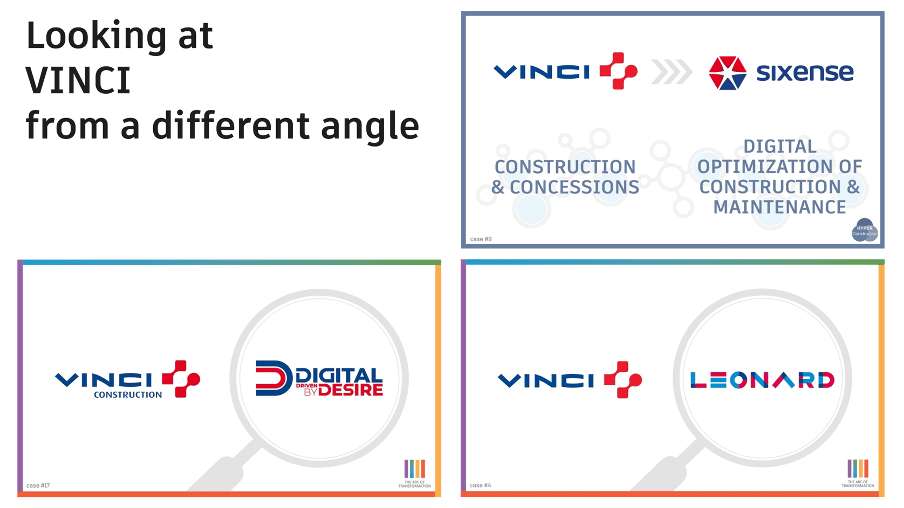
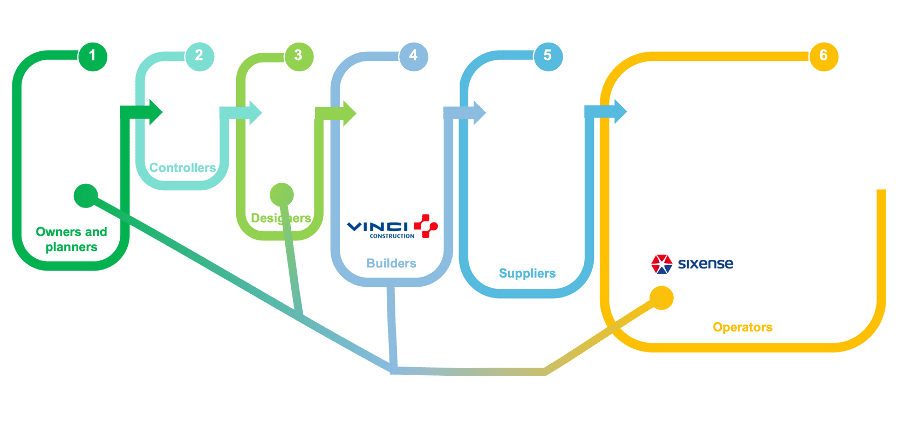
Holcim is a leading global supplier of cement, aggregates, and ready-mix concrete. With a presence in more than 70 countries, Holcim plays a vital role in the construction industry, providing essential building materials for infrastructure projects, residential buildings, and commercial structures. The company greatly emphasizes sustainability, aiming to reduce its carbon footprint and promote the circular economy through innovative solutions like low-carbon cement and recycled aggregates. Holcim's commitment to building a greener future sets it apart as an industry leader.
Holcim actively pursues diversification and innovation through various initiatives. One notable initiative is ORIS, the first construction materials platform for the intelligent use of resources and low-impact infrastructure. Supported by artificial intelligence and its unique algorithms, ORIS assesses the impact of linear infrastructure designs in a multidimensional way. The platform calculates parameters and data such as material properties, geolocation, expected traffic, and weather conditions for optimized and sustainable construction efficiency. Based on this data-driven analysis, users make informed decisions for intelligent material consumption. Additionally, Holcim has established the Holcim Accelerator program, which collaborates with startups to explore innovative solutions and technologies in the construction industry. Holcim provides mentorship, funding, and access to its vast network through this program, fostering entrepreneurship and driving innovation.
Moreover, Holcim Maqer is another initiative that engages startups and entrepreneurs to develop disruptive ideas in the construction materials space. This initiative supports projects that have the potential to transform the construction industry and promote sustainability. These efforts by Holcim demonstrate its commitment to diversifying its activities and embracing innovation, aiming to shape the future of construction materials and drive sustainable development.
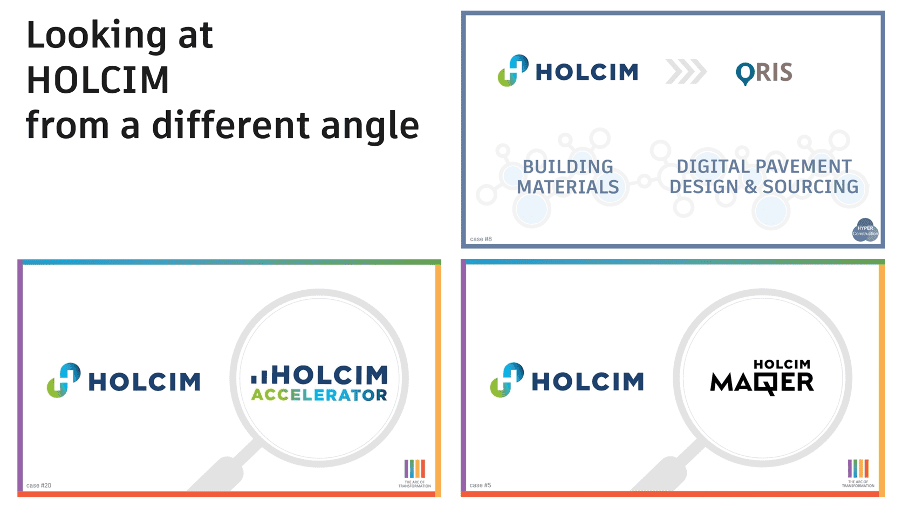
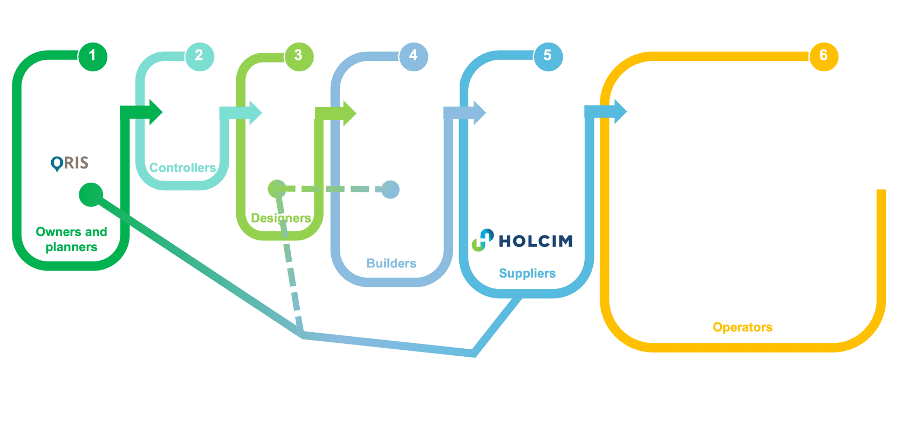
There are many other examples of large firms re-inventing their businesses with digital. The Hyper Construction and Arc of Transformation collections are expanding monthly with new cases. All cases are explained, and refer to company websites for more details.
No matter what value you aim to receive, a business model exists behind it. “A business model describes the rationale of how an organization creates, delivers, and captures value in economic, social, cultural, or other contexts,” explained Steve Blank, a Silicon Valley entrepreneur who launched the Lean Startup movement.
Business models are invisible but essential mechanisms enabling an organization to create and capture value, generate profits, and stay relevant. Owners, planners, architects, builders, building product providers, and facility management firms all have a business model and are usually part of a bigger network called the value chain.
While construction firms have engineers and technologists in their ranks, these personae typically don't consider the business model aspect at stake. Yet, they need to know what is going to be the business model associated with the technology they are developing to make the most out of it.
Recently technology was used solely for defensive plays, including BIM, robotics, IoT, AR/VR, and artificial intelligence. The objective of deploying these technologies usually is to optimize the company's current business and increase productivity across the company. But once they tested and implemented these technologies, these engineers understood that they could also sell new services to their ecosystem for internal use and then external.
To play defense, the business model aspect is not so critical. But the business model aspect becomes crucial when you want to play offense and try to sell new services to third parties in your ecosystem. This is why designing the business model before technology is built or acquired is critical. This is true for every technology and even more true when companies want to build their own platform.
The significant advantage of designing a business model is that it is inexpensive. All you need is to create a document. When you are thinking of a business model beforehand, even if you're going to evolve it, at least you have some guidance for how you're going to execute certain things. Having the business model upfront allows you to think differently about how you might do different executional elements. This is even more true in the case of large companies where the level of complexity can be extremely high with all the decisions you must make.
When I started to speak about the Invisible Revolution, gaining buy-in from those across the industry was challenging. So, I decided to collect cases to inventory the strategic moves of the most prominent players across the construction industry. One objective was to show people around me that this Invisible Revolution is a reality. Later, instead of keeping this collection on my laptop, I showed it to our customers. The collection is now quite large, with a total number of 66 cases today and growing.
All cases are made of information publicly available on the companies’ websites. It is about corporate initiatives taken by large construction firms (and other large companies in their ecosystems) to pivot their business, including modernization of their organization, new digital ventures, cultural transformation, platform thinking, open innovation, corporate venture capital, digital hubs, and more. This non-academic research inspires companies and opens their minds to new things and possibilities. They see more clearly the global competitive landscape around them and understand patterns and trends like corporate venture capitals (CVCs), open innovation initiatives, digital platforms, and new partnerships. It gives firms perspective on what is happening globally and makes them proud of the construction industry, which is an important step forward regarding mindset and energy.
Hyper Construction is where I store examples of new digital ventures and other types of growth initiatives that are very strategic for large engineering firms and construction firms worldwide. The Arc of Transformation is somehow the other side of the record. Here, I put examples of cultural transformations and organizational changes. Many people follow this work, and now more and more people spontaneously come to me to offer new cases to publish. From my knowledge, this is the largest collection of strategic moves in construction ever assembled.
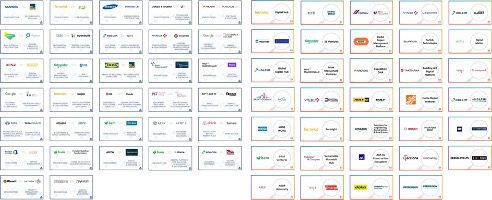
We use these compelling examples as powerful tools to inspire customers from around the globe during our engaging presentations and interactive workshops. Through these impactful sessions, we aim to ignite a spark of innovation and fire the imaginations of individuals, encouraging them to think beyond traditional boundaries and embrace the transformative potential of new technologies. Moreover, we have taken proactive steps to cultivate a vibrant and diverse network of contributors, encompassing passionate individuals within Autodesk and talented visionaries outside our organization. This collaborative approach ensures that our movement for reimagining construction as a business remains dynamic, continuously evolving, and enriched with fresh perspectives. Together, as a tightly knit community of like-minded professionals, we foster an environment that nurtures creativity, encourages knowledge exchange, and fuels the collective drive toward shaping a brighter future for the construction industry. We intend to draw lessons from these cases and present our research results. What makes a digital transformation work? How to do it? What are the fundamental steps you need to make to secure long-term and sustainable success? How will it impact your workforce? How will you manage change within your organization? What type of new partnerships will you need to build? How can you stay agile and open along the journey?
Now think of the company you work for. Shouldn’t it anticipate and prepare a portfolio of business models to be more resilient in the future? Here is what needs to be considered:
In conclusion, the construction industry is undergoing a remarkable phase of business reinvention driven by the pressing need for sustainability, digitalization, and innovation. Companies within the sector are embracing new technologies, adopting sustainable practices, and reimagining traditional processes to meet the evolving demands of a rapidly changing world. The shift towards eco-friendly materials, renewable energy integration, and smart infrastructure benefits the environment and presents immense opportunities for growth and profitability.
As construction firms continue reinventing themselves, they become catalysts for positive change, driving economic development and creating sustainable communities. The industry's focus on collaboration, partnerships, and disruptive ideas is fostering a culture of innovation and pushing boundaries. With the advent of advanced construction techniques, artificial intelligence, and robotics, the potential for increased efficiency, reduced costs, and improved safety is becoming a reality.
While challenges may persist, the construction industry's commitment to business reinvention is paving the way for a greener, more resilient, and technologically advanced future. By embracing sustainable practices, leveraging cutting-edge technologies, and fostering innovation, the construction sector is poised to play a pivotal role in shaping a better world for future generations. The future of construction is bright as businesses reinvent themselves to create sustainable, intelligent, and inspiring infrastructure for the benefit of society.

May we collect and use your data?
Learn more about the Third Party Services we use and our Privacy Statement.May we collect and use your data to tailor your experience?
Explore the benefits of a customized experience by managing your privacy settings for this site or visit our Privacy Statement to learn more about your options.